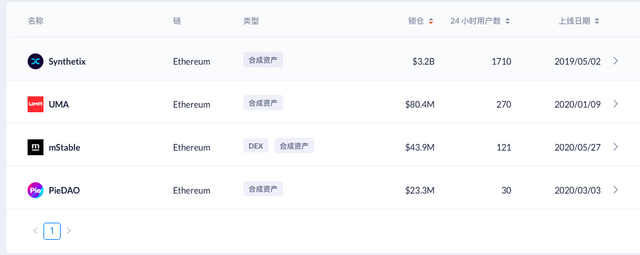.jpeg)
After accumulation and precipitation last year, the decentralized exchange Uniswap and the lending agreement Compound have achieved breakthroughs at different levels with the development of DeFi last year, but they have not been used on a large scale in the field of derivatives. It should be understood that in the traditional financial sector, the volume of derivatives is 40 to 60 times that of the spot, and in the encrypted market, the trading market value of derivatives still accounts for less than half of the volume of the entire digital asset market. In contrast, there is still huge room for imagination in the development of derivatives. This situation has also seen the light this year. A very simple example is that under the momentum of Bitcoin's surge this year, due to the instability of value, many Institutions began to try to use derivatives to avoid risks, discover prices, arbitrage, and obtain more value capture. It can be said with certainty that the greater the popularity of crypto assets and DeFi, the stronger the demand for derivatives will be, and the speed of market penetration and transmission will continue to accelerate, which will stimulate the continuous emergence of new species in the market to compensate for the current situation. There are gaps and demands in the market.

The definition of financial derivatives generally refers to a bilateral contract that has a transaction swap relationship between the two, or a bilateral contract that transfers risks to the trader, which gives the holder a certain obligation or the option to buy or sell a financial asset. Its value is determined by the price of the financial assets it trades, such as options, futures, and swap contracts. In the DeFi field, the definition of derivatives is roughly similar to the above definition. At present, from the perspective of relatively fair mainstream types, there are mainly trading options and futures, synthetic assets, etc., and decentralized insurance and oracle tools are still very large separate sectors. Below we still understand this track through the types of mainstream derivatives.
Trading derivatives
The first category is Bitcoin futures products. According to data from Glassnode, an encrypted market data aggregation service provider, Bitcoin futures trading volume has been steadily increasing since November last year, and the current average daily trading volume of Bitcoin futures has exceeded 180 billion US dollars. In addition, Bitcoin options trading has also seen a surge, and this year will usher in a new record level. At present, some exchanges have realized regular custody of more than 1 billion US dollars of daily average trading volume. The ever-increasing trading volume has also promoted more institutional units to start attempts of such products. According to public news reports, in early March, Goldman Sachs announced that it had restarted the cryptocurrency trading desk and began to provide customers with bitcoin futures and no-principal delivery. Forward contract (NDF) trading services; Later, Giant Steps Capital, the largest quantitative asset management company in Latin America, also announced that it would launch a fund focused on investing in Bitcoin and other digital asset futures, and using machine learning strategies to trade Bitcoin and similar Asset futures. Regarding Bitcoin options and futures trading is entering the incremental market, the more positive news is that in addition to Bitcoin, various exchanges have launched other cryptocurrency derivatives trading. It is also constantly evolving.
In addition to centralized exchanges and financial institutions, the other category is the development of decentralized derivatives agreements. Including dYdX, Kine, and Injective are all projects that carry out futures trading. dYdX was born in 2017 and is a very early DeFi derivative agreement. It adopts the transaction method of off-chain order book and on-chain settlement. In addition to perpetual contracts, it also includes functions such as lending and leveraged transactions. Currently, the project’s perpetual contracts are running on Ethereum’s Lay1, and Lay2 mainnet testing is also Synchronization is in progress. Kine is a model similar to a centralized exchange. It uses "chain trading" and the "Peer to Pool" trading method promoted by Synthetix. Trading users can have unlimited liquidity and zero slippage. The transaction takes place off-chain, so it will not be greatly affected by the performance of the public chain, ensuring the transaction speed. The disadvantage is that Kine cannot be called a decentralized protocol party, and there are certain security risks.
Representative options for options include Opyn, Hegic, etc. The Opyn agreement allows users to create call or put options, and users can buy and sell options for a given product, delivery time, and exercise price. In terms of the trading time of options, Opyn uses European-style cash-settled options, that is, option holders do not need to take any measures on or before the expiry date, and delivery will be automatically executed at expiration, and the products are all USDC priced, and option sellers need to have A 100% pledge deposit is used as a guarantee to deal with market risks. Hegic solves the liquidity problem of option products through a liquidity pool. Currently, options include BTC and ETH. Users can provide funds in Hegic to form a liquidity pool. These funds will be used to automatically sell call and put options and become a buyer’s transaction. opponent. While the liquidity provider bears option risks, it also enjoys the benefits of selling options.
In perpetual contract derivatives, dFuture can be regarded as an innovative agreement. The agreement does not use the traditional order book transaction model, but solves the problems of transaction depth, liquidity and control through an innovative "constant sum formula". It also introduces multiple external oracles and decentralized exchanges to feed prices to obtain the current quotation of the trading category, and form an index price through a weighted average. Guarantee the risk-free profit of LP to the greatest extent. At present, the platform has been deployed on the HECO chain and the BSC chain, and has stabilized initially. Because it relies on the advantages of the transaction public chain’s own traffic attributes, it also undertakes most of the customer traffic forced away from the congestion of Ethereum, so the overall The development is fairly smooth.
Synthetic asset class
Synthetic assets are to build almost all assets with a price through asset agreement mapping to realize a simulation expression of the original assets, but this is not the original asset itself, nor does it mean that you have the ownership of the asset in the real world, just It anchors the price of the asset and is an alternative expression of the parallel world of existing assets on the chain. At present, it is possible to synthesize stocks, as well as assets such as legal currency, gold, and BTC. The most representative of the synthetic asset track is undoubtedly Synthetix, a synthetic asset issuance protocol based on Ethereum. It supports synthetic assets including legal currency, cryptocurrency, and commodities. It is mainly based on debt pools to track basic assets, and supports users to provide collateral in the form of SNX Token, thereby casting synthetic assets. The total locked position has exceeded 3.2 billion US dollars since its birth more than two years ago. Ranked the top of the synthetic assets list, opening a huge gap with other projects.
 (Data source: Debank)
(Data source: Debank)
Another fierce increase in synthetic assets is Mirror. Last month, Robinhood (Robin Hood), a brokerage platform where investors rallied to fight the main battlefield, was announced by many local securities firms to restrict the opening of GME and AMC stocks. The asset platform took the opportunity to launch a vote and launched a synthetic asset transaction corresponding to GME stock, providing investors with trading needs with new possibilities that are not restricted by centralized platform trading. As a rookie, Mirror has developed rapidly and has become the largest synthetic U.S. stock trading platform. More than 20 synthetic assets have been launched on the platform, covering U.S. stocks, encrypted assets, and commodities. Generally speaking, Mirror is one step ahead of market demand insights. Opportunities are constantly emerging.
Supercash, another decentralized synthetic derivatives platform, claims that it has banknote capabilities, which allows free addition and free trading of various digital asset derivatives currency pairs in a single currency. Supports trading pairs including BTC, ETH, ERC-20s, gold, stocks, etc. The oracle service is also introduced from the outside to the current independent research and development. The platform's greater outstanding ability is the ability to synthesize automatic market makers, which allows liquidity providers (LP) to provide only one asset, and another asset will be automatically synthesized by smart contracts. That is, in the assets you provide, half of the assets will automatically create futures positions through the contract, which greatly reduces the user’s participation threshold. In addition, the automatic liquidator smart contract introduced to assist in the liquidation is similar to AMM's passive market maker model allows anyone to provide liquidity through the agreement to become an automatic liquidator. Based on the customer base of a large number of liquidators, the platform has further transformed the liquidation pool business into a unique product for other DeFi projects. Provide clearing services.
Riding on the borderlessness of the crypto market and the innovative combination of market elements has enabled the general public to participate in asset transactions. Synthetic assets is a derivatives track that has great imagination. Specifically, it uses blockchain to decentralize Trading platform operators, with features such as permission-free access, simulate hot investment scenarios on the chain, and provide ordinary investors with low thresholds with an excellent way to trade diversified asset classes such as US stocks and gold. In addition, synthetic assets are almost unconstrained in the richness of assets. They can cover gold, crude oil, U.S. stocks and even the foreign exchange market. There are no licenses for trading varieties, and any assets with open prices can be traded. This all caters to the development of traditional finance and the existing DeFi market.
In addition to the aforementioned futures, options, and synthetic assets, there are also other types of derivatives such as augur prediction markets, Nexus Mutual insurance, and interest rate swaps. In fact, we found that now DeFi derivatives are no longer just serving the original encrypted assets on the chain, and are constantly exploring unknown areas, with more open and transparent infrastructure, and more diversified and fair financial distribution models. Make the assets on the chain and all the assets that anchor real asset transactions simple, and truly ensure the safe and secure transactions of users. Compared with the large promotion costs of most derivatives in the traditional financial field, derivatives in the DeFi field are created at almost zero cost and quickly promoted to the trading market, because the DeFi ecosystem includes oracle services, asset agreements, transaction layers, data layers, and clearing layers. With the ecological components of the insurance layer and the derivatives trading layer, the achievable high degree of freedom of financial Lego combined innovation drive, the creators of derivatives can leverage more market opportunities with fewer resources, and unilateral innovation in the derivatives field Perfection also makes the network effect of the entire DeFi ecosystem stronger. It directly brings a very different experience to the entire ecological construction and user awakening. In the future, the derivatives market will flourish, and the coexistence of multiple strengths in the future will also be the inevitable trend of the development of the industry. In short, the future of DeFi derivatives will exceed the development potential of traditional financial perspectives and unleash unlimited possibilities.